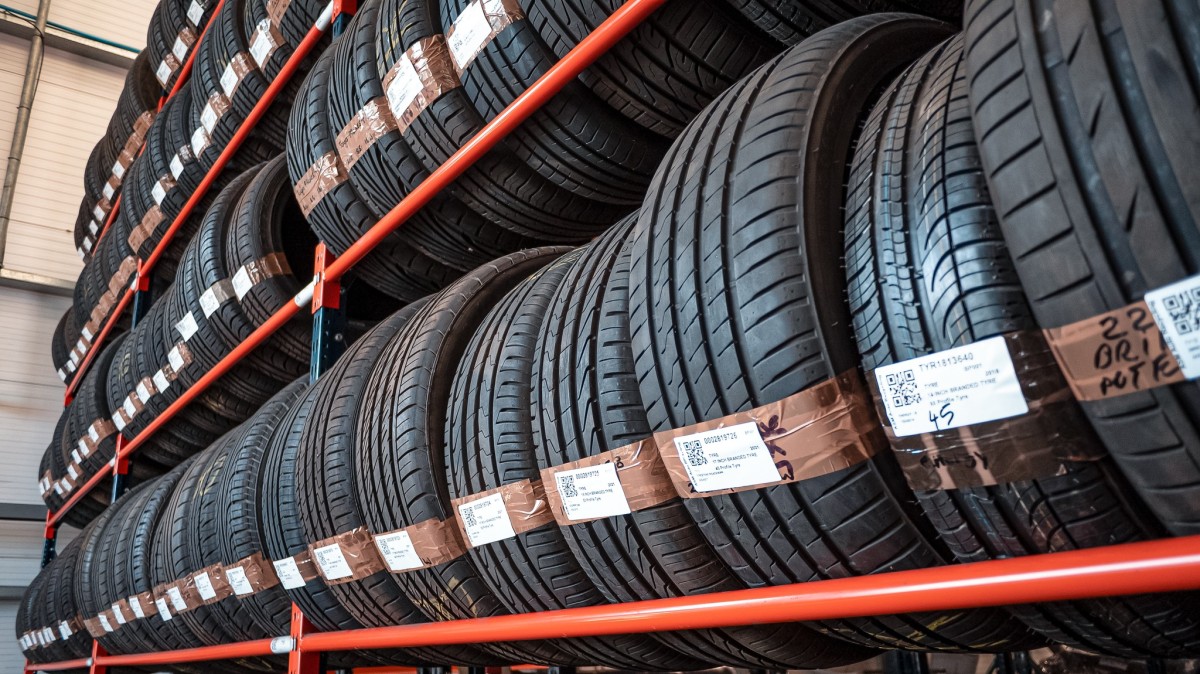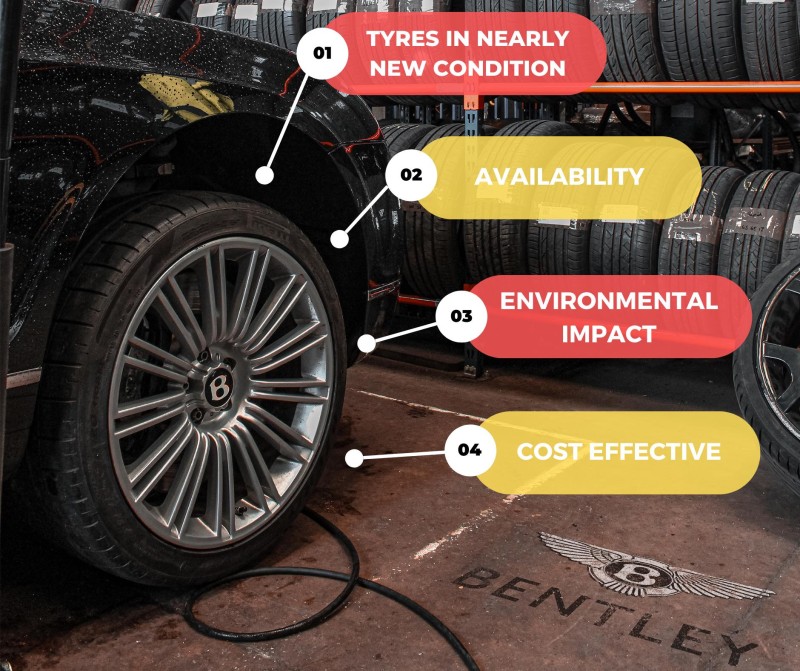Our Scrappage, Recycling and Car Blog
later post | index | earlier post
Our Guide to Pre-Worn Tyres
Tuesday, 29 October 2024
The Tyre Industry Federation estimates that 10% of all tyres bought in the UK are part-worn. That’s about 5 million tyres that are not brand new when they are fitted to vehicles. Reputable tyre retailers will ensure the tyres they sell are above the legal standard, but not every dealer is so diligent.
What do you need to look out for when buying part-worn tyres, and what are the warning signs?

What are part-worn tyres?
For some years, the part-worn tyre has been a popular alternative to the (now largely extinct) remoulded tyre, which involved recladding a worn-out tyre with new rubber. In contrast, a part-worn tyre is simply a tyre which has previously been used on another vehicle. These are often taken from a vehicle before it is scrapped, if the tyres are deemed roadworthy and valuable enough to be salvaged.
Are part worn tyres legal in the UK?
Part-worn tyres or second-hand tyres are perfectly legal – if they are kept to the minimum standard. This means that the tread depth should be at least 1.6mm – although it is recommended that tread depth shouldn’t go below 2mm and most experts suggest replacing tyres at 3mm.
Nevertheless, many tyres sold in the UK have been found to not even reach this legal minimum. In fact, TyreSafe, a UK tyre safety charity, found that 94% of part-worn tyres they inspected were classed as illegal, with 63% unsafe to return to the road.
How long do part worn tyres last?
Every second-hand tyre will have a different lifespan, depending on the condition it is in when fitted, its tread depth and the mileage of the vehicle. However, it is estimated that a part-worn tyre with 3mm of tread depth will be able to run for around 14,000 miles (or about two years driving).
Should I buy new or part-worn tyres?
Price is the only reason someone might consider buying part-worn tyres. Completely replacing your vehicle’s tyres with brand new ones can be two or three times as expensive. It’s therefore entirely understandable that the average budget-conscious motorist could be attracted to the cheaper alternative.
Are used tyres safe?
The safety criteria of part-worn tyres is laid out in the UK by the Motor Vehicle Tyres (Safety) Regulations 1994. It is an offence to sell tyres that do not meet these standards. However, the reality is that the law is not enforced satisfactorily, and there is no independent industry body to ensure uniform standards. This makes it all too easy for rogue traders and unscrupulous dealers to allow poor-quality products onto the market.
Are part-worn tyres worth the risk?
Every individual will have their own experience of part-worn tyres. For some drivers they are a great budget option because they keep their vehicle on the road at a fraction of the asking price of new tyres. For others, a part-worn tyre purchase might have led to an accident, blow-out or breakdown.
Some used tyres actually have safety benefits, such as specialist winter tyres.
If drivers know what to look for, however, there’s no reason why you can’t buy a set of part-worn tyres which will see you through a healthy amount of mileage.
Part-worn tyre buying guide

Buy big brands
Large corporations and vehicle manufacturers tend to care more about regulations – and ultimately their image – than a back-street garage does. Buying from a brand you can trust is a good way to ensure the part-worn tyre you get is built to a recognised standard.
Buy in bulk
Driving on a used tyre which doesn’t match the other three is not the best idea. Buying used tyres in a pair or a set can be advantageous, as you can ensure that both tyres on an axle are matching.
Check tread wear
A new tyre should have a tread of roughly 8mm. When the tread wears down to between 2-3mm, this is the point where most industry experts recommend seeking a replacement. A tyre which has hardly been used should guarantee plenty of mileage – look for those which are nearing 8mm depth and evenly worn all the way round. Make sure the original grooves are clearly visible, and there are no lumps or bulges internally or externally. None of the ply or cord should be exposed.
Check sidewall damage
After tread wear, you should check the sidewalls for scrapes, cuts, eroded rubber or any signs of previous damage. Damage on the sidewalls can indicate a fundamental problem with the tyre as a whole, so be sure to investigate the internal sidewall as well.
Check for repairs
Tyres which have been punctured in their previous life are often plugged with rubber to seal against any leaks. There’s nothing wrong with these repairs, in principle. However, visible repairs could indicate a deeper problem limiting the tyre’s maximum speed rating or overall effectiveness. If you see one of these indicators, check the interior of the tyre. You may unearth structural damage to the tyre belts, a definite deal-killer.
You have been (part) warned!
Part-worn tyres remain controversial within the industry, and not without reason. Knowing the source of your tyres, and their history, is increasingly important for anybody looking to buy second-hand. While there will always be a need to check the quality of the tyres you’re buying, this extra responsibility can be shared by going to a company you can trust, like ASM Auto Recycling.
ASM Auto Recycling puts tyre quality first
The tyres sold by our team at ASM are in virtually mint condition, more nearly-new than part-worn. When scrapping a vehicle, we tend to source our tyres from unused spares instead of those which have been on the road.
Our staff are professionally trained and accredited to judge the quality of any tyre, which is why we check tread depths, tyre pressure and more before selling to any of our customers. We won’t ‘tyre’ of giving you great service!
later post | index | earlier post
Categories
- Car Maintenance 25
- Driving Abroad 2
- Economy 1
- Environment 3
- Insurance 2
- Light-Hearted 1
- Motoring Guides 6
- Motorways 1
- New Car Sales 1
- Safety 4
- Salvage 14
- Social & Community 5
- Used Cars 19
- Winter Driving 2
Recent posts
- Car Cleaning Tips
- The Most Stolen Cars in UK
- ABI Vehicle Salvage Code of Practice
- Car CO2 Emissions
- How To Replace A Car Air Filter
- Recycling a Car: 5 Fascinating Facts
- Clocking, Cloning, Ringing and Cut & Shut
- MOT: the complete guide
- Used Tyres Guide
- What is GAP insurance?
- Guide to finding a replacement car engine
- Does the scrap value of steel affect your car’s scrap value?
- What are the most valuable salvage car parts?
- The Ultimate Guide to Replacing Wing Mirrors
- ASM Has Procured Over 350 Jaguar and Land Rover Flood-Damaged Cars!